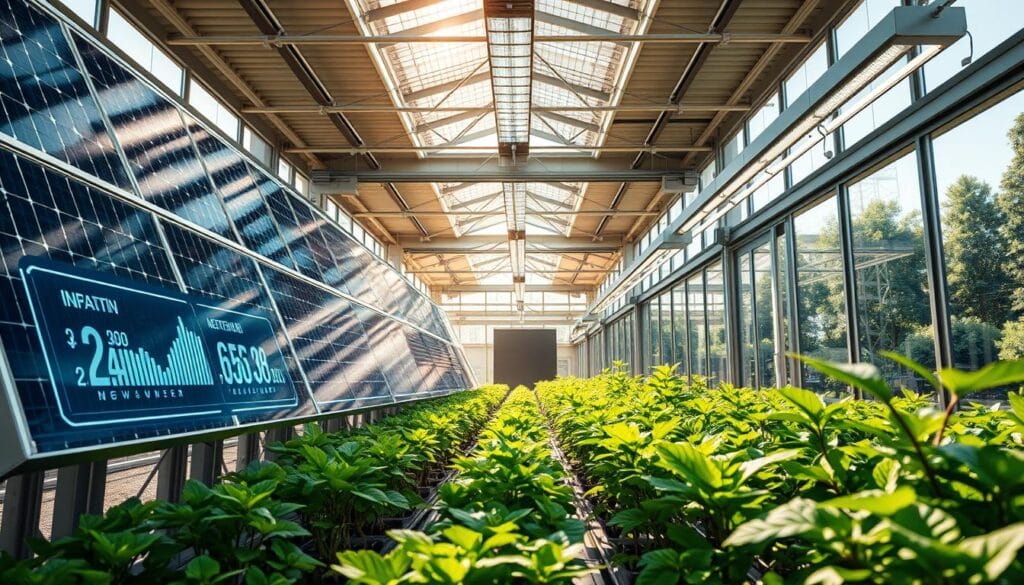Horticulture:Greenhouse Energy Loading&Gas to kWh Conversion

I’m passionate about sustainable agriculture and horticulture, especially the potential of greenhouses. These controlled spaces enhance crop yields and represent the future of food production. However, their high energy use impacts both the environment and costs.
So, I’m excited to explore greenhouse energy loading and how to convert gas to kilowatt-hours (kWh). This is key to understanding and improving these systems.
If you run a greenhouse, work with energy, or just find this interesting, keep reading. We’ll look at how to measure and manage greenhouse energy. This will help make your operation more sustainable and cost-effective.
Let’s start our journey into greenhouse energy. Here, efficiency, innovation, and caring for the environment come together. They shape the future of how we grow food.
Table of Contents
Fundamentals of Greenhouse Energy Systems
Greenhouses need different energy sources to keep plants growing well. Greenhouse heating systems and greenhouse cooling systems help control temperature and humidity. This is key for plant growth and keeping costs down.
Types of Energy Sources in Modern Greenhouses
Today’s greenhouses use many energy sources. These include:
- Electricity from the grid
- Natural gas for heating and co-generation
- Renewable energy like solar, wind, and biomass
Basic Energy Loading Concepts
Energy loading is how much energy a greenhouse uses. It’s measured in Btu or kWh. The mix of energy sources affects a greenhouse’s carbon footprint and how well it works.
Energy Measurement Units Explained
Knowing about energy units is key for managing greenhouse energy. Some common ones are:
- British Thermal Units (Btu): A way to measure heat energy, often for fuel use.
- Kilowatt-hours (kWh): A way to measure electrical energy, used for bills.
- Therms: A unit for natural gas energy, with 1 therm being 100,000 Btu.
Understanding these units helps greenhouse owners make better energy choices. This leads to better energy efficiency in greenhouses.
“Renewable and alternative energy sources can cover a significant part of household or operation’s electricity needs depending on capacity and usage.”
The Science Behind Gas to kWh Conversion
Understanding how to convert gas to kilowatt-hours (kWh) is key. This helps you figure out the carbon footprint of greenhouses. It also guides you in choosing the best energy-saving plans.
The conversion depends on the energy content and how well different fuels burn. For example, burning natural gas releases about 0.00005311 metric tons of carbon dioxide equivalent (tCO2e) per kBtu. On the other hand, #2 fuel oil releases 0.00007421 tCO2e per kBtu. Knowing these emission factors is vital for accurate greenhouse gas emissions calculations.
The Energy Information Administration (EIA) offers important data. This data helps estimate carbon emissions per kBtu or kWh in various states. Using this info, you can better understand your greenhouse’s environmental impact. This knowledge aids in making smarter energy management choices.
“Controlling greenhouse gas emissions and reducing the carbon footprint of greenhouses is essential for sustainable agricultural practices.”
The science of converting gas to kWh is vital for the greenhouse industry’s environmental goals. By mastering this conversion, you can greatly reduce greenhouse gas emissions. This move enhances the sustainability of your greenhouse operations.
Calculating Greenhouse Gas Emissions from Energy Usage
It’s important to know how greenhouses affect the environment. You must look at both direct and indirect sources of emissions. Direct emissions come from burning fuels like natural gas or propane. Indirect emissions are from the electricity you buy to power your greenhouse.
Direct Emissions Calculation Methods
To figure out direct emissions, use the EPA’s Greenhouse Gas Reporting Program (GHGRP). This tool gives you the data you need to find out how much CO2, CH4, and N2O your greenhouse emits.
Indirect Emissions Assessment
For indirect emissions, check the eGRID database. It has emission factors for different areas. By multiplying your electricity use by the right factor, you can estimate your indirect emissions.
Carbon Footprint Metrics
Calculating your carbon footprint gives a full picture of your greenhouse’s impact. It shows CO2 emissions per unit of energy. This lets you compare your greenhouse to others or to different energy sources.
| Emission Source | Calculation Method | Key Metric |
|---|---|---|
| Direct Emissions | EPA’s GHGRP | CO2, CH4, N2O emissions from on-site fuel combustion |
| Indirect Emissions | eGRID database | CO2 emissions from purchased electricity |
| Carbon Footprint | Total emissions per unit of energy consumed | CO2 emissions per kWh or therm of energy |
Knowing your greenhouse’s emissions helps you make better choices. You can work on using less energy and cutting down your carbon footprint.
Horticulture Greenhouse Energy Loading Gas to kWh
Horticulture greenhouses are key to modern farming, offering perfect conditions for many crops. Managing energy well is vital, affecting costs, the environment, and success. By changing gas use to kWh, greenhouses can compare energy better and find ways to save.
Converting gas to kWh means looking at how much energy is used. This includes changes with the seasons, different crops, and the greenhouse’s design. This helps horticulture experts make better energy plans, making greenhouses more efficient.
The ASHE’s Energy to Care® program is a great tool. It helps greenhouses compare their energy use and see how they’re doing over time. With this, managers can use energy better, cut down on carbon, and make their greenhouses more sustainable.
| Key Greenhouse Energy Metrics | Value |
|---|---|
| The Garden‘s carbon dioxide emissions reduction from electric equipment | 50 tons annually |
| Solar array power generation at the horticulture barn | 17,522 kWh (121% of previous usage) |
| Grants received for the solar project | $112,000 from Massachusetts Cultural Council and $50,000 from Tern Foundation |
| Plant material sourced from within 150 miles | Around 95% |
| Greenhouse gas emissions saved by electric vehicle charging stations | Over 9,000 kg, equivalent to planting 230 trees |
By using gas-to-kWh conversion and smart energy plans, greenhouses can use energy better. This helps the environment and supports growing sustainable farming.

Energy Efficiency Strategies in Greenhouse Operations
Greenhouse operators can use many ways to cut down energy use. They can use new technologies and better ways of working. This makes greenhouses more energy-efficient and helps the environment.
Heat Recovery Systems
Heat recovery systems are key for better energy use in greenhouses. They take waste heat from processes and use it to warm the greenhouse or make hot water. This cuts down on energy waste and makes the greenhouse more efficient.
Thermal Screen Technologies
Thermal screens help keep the greenhouse at the right temperature and humidity. They keep heat in when it’s cold and out when it’s hot. This makes the greenhouse more energy-efficient and keeps the climate stable for plants.
Ventilation Optimization
Good ventilation design is important for energy-saving greenhouses. Using variable-speed fans and smart vent placement helps control the climate. This way, the greenhouse stays at the right temperature and humidity without using too much energy.
Using these energy-saving methods, greenhouses can use less energy, save money, and help the planet. Investing in new technologies and better ways of working can save energy and reduce environmental impact over time.
“Implementing energy-efficient strategies in greenhouse operations is not only economically beneficial but also aligns with the growing demand for sustainable agricultural practices.”
Monthly vs Hourly Energy Consumption Analysis
Choosing between monthly and hourly analysis for greenhouse energy use is crucial. Monthly analysis is simpler but might miss up to 7% of greenhouse gas savings. Hourly analysis gives a clearer picture of energy use patterns.
Understanding peak energy demand is key. Hourly analysis helps in finding ways to shift loads. This can lead to big energy savings and less emissions.
| Analysis Method | Advantages | Disadvantages |
|---|---|---|
| Monthly |
|
|
| Hourly |
|
|
The choice between monthly and hourly analysis depends on the greenhouse’s goals. Monthly analysis is good for simple energy management. But for those aiming for top energy efficiency and emissions cuts, hourly analysis is better.

“Choosing the right energy consumption analysis method can make a significant difference in the greenhouse’s energy efficiency and emissions reduction efforts.”
Renewable Energy Integration in Greenhouse Systems
The need for sustainable food production is growing fast. Greenhouse operators are turning to renewable energy to cut costs and reduce carbon emissions. They’re finding new ways to use clean energy in their greenhouses.
Solar Power Applications
Solar power is a big hit for greenhouses. PV panels on roofs or walls make electricity without pollution. Solar thermal systems also help with heating and hot water, cutting down on fossil fuel use.
By using the sun’s power, greenhouses can save money and lower emissions. This is especially true in sunny areas.
Wind Energy Solutions
Wind energy is another good choice for greenhouses, especially in windy rural spots. Small wind turbines can power the greenhouse or feed into the grid. Using both solar and wind energy makes greenhouses more self-sufficient.
Biomass Integration Options
Greenhouse owners are also looking into biomass energy. This uses organic waste like plant trimmings or animal manure to make energy. Biomass systems can heat, steam, or power greenhouses, reducing fossil fuel use.
The National Renewable Energy Laboratory’s Cambium Data Set helps greenhouses understand the benefits of renewable energy. By adopting these clean energy solutions, growers help make food production more sustainable and eco-friendly.
Energy Auditing and Performance Monitoring
Keeping greenhouses running well needs regular checks on energy use. The American Society of Heating, Refrigerating and Air-Conditioning Engineers (ASHRAE) offers tools for these audits. They help check current conditions, system operations, and ways to get better.
It’s key to watch energy use closely to spot issues and chances to do better. Using strong energy management systems gives real-time energy use data. This helps greenhouse managers make smart choices to boost energy efficiency in greenhouses.
Comprehensive Energy Audits
ASHRAE’s audit plan has different levels to check greenhouse energy audits:
- Level 1: Walkthrough Audit – A quick look at how much energy is used and ways to save.
- Level 2: Energy Survey and Analysis – A detailed look at energy use, systems, and how things work to find ways to save more.
- Level 3: Detailed Energy Audit – A deep dive into energy systems to find big savings opportunities.
Continuous Greenhouse Energy Management
Using energy management systems lets operators see and study energy use as it happens. This helps spot trends, oddities, and chances to get better. It makes greenhouses more energy-efficient overall.
| Key Benefits of Energy Auditing and Monitoring |
|---|
| • Identify energy-saving opportunities |
| • Optimize energy systems and operations |
| • Reduce energy costs and emissions |
| • Improve overall energy performance |
By doing thorough audits and always watching performance, greenhouse managers can make big improvements in greenhouse energy management. This leads to a greener, cheaper future.
“Effective energy management is the cornerstone of sustainable greenhouse operations. By leveraging the power of comprehensive audits and real-time monitoring, we can unlock new levels of efficiency and cost savings.”
Cost-Benefit Analysis of Energy Conversion
When you think about energy conversion in your greenhouse, doing a cost-benefit analysis is key. You need to look at the costs of equipment, installation, and any disruption to your work. But, the long-term savings are big, like lower energy bills, less maintenance, and possible tax breaks for green tech.
Think about how energy prices might change and new rules on greenhouse gases. By comparing the upfront costs to the long-term gains, you can choose wisely. This choice will help your greenhouse use energy better and be more sustainable.
Initial Investment Considerations
First, figure out how much you’ll spend on your energy project. This includes buying and setting up new gear, like solar panels or smart HVAC. You also need to think about any work stoppages and training for your team.
Long-term Operational Savings
The upfront costs are big, but the savings over time are even bigger. Switching to efficient tech means lower energy bills and more savings. Plus, you might get tax breaks or other perks for going green.
FAQ
What is the process of converting gas to kilowatt-hours (kWh) in greenhouses?
What are the different energy sources used in modern greenhouses?
How does the conversion from gas to kWh work?
How can greenhouse gas emissions be calculated?
What are the key considerations for managing energy in horticulture greenhouses?
What are some common energy efficiency strategies for greenhouses?
How do monthly and hourly energy consumption analyses differ in greenhouse operations?
What are the options for integrating renewable energy in greenhouse systems?
How can energy auditing and performance monitoring improve greenhouse operations?
What are the key considerations for a cost-benefit analysis of energy conversion projects in greenhouses?
Source Links
- Assessing the Physical and Environmental Aspects of Greenhouse Cultivation: A Comprehensive Review of Conventional and Hydroponic Methods – https://www.mdpi.com/2071-1050/16/3/1273
- Advances in Solutions to Improve the Energy Performance of Agricultural Greenhouses: A Comprehensive Review – https://www.mdpi.com/2076-3417/14/14/6158
- Renewable Energy: Use and Efficiency | Penn State Extension – https://extension.psu.edu/energy/renewable-and-alternative-energy/energy-use-and-efficiency
- Heating, Ventilating and Cooling Greenhouses – https://ceac.arizona.edu/sites/default/files/asae_-_heating_ventilating_and_cooling_greenhouses.pdf
- Green building practices to integrate renewable energy in the construction sector: a review – Environmental Chemistry Letters – https://link.springer.com/article/10.1007/s10311-023-01675-2
- Synthesis and Optimisation of an Integrated Renewable Energy and Greenhouse Network – Process Integration and Optimization for Sustainability – https://link.springer.com/article/10.1007/s41660-023-00386-z
- PDF – https://cannabis.ny.gov/sustainability-guidance
- Sustainability at the Garden – New England Botanic Garden at Tower Hill – https://nebg.org/sustainability-at-the-garden/
- PDF – https://par.nsf.gov/servlets/purl/10409935
- Optimizing Energy Consumption in Agricultural Greenhouses: A Smart Energy Management Approach – https://www.mdpi.com/2624-6511/7/2/36
- Improving On-farm Energy Use Efficiency by Optimizing Machinery Operations and Management: A Review – Agricultural Research – https://link.springer.com/article/10.1007/s40003-024-00824-5
- Improving the sustainability and effectiveness of photovoltaic evaporative cooling greenhouse in the Sahel – Scientific Reports – https://www.nature.com/articles/s41598-024-51352-9
- Techno-economic and environmental analysis of renewable energy integration in irrigation systems: A comparative study of standalone and grid-connected PV/diesel generator systems in Khyber Pakhtunkhwa – https://pmc.ncbi.nlm.nih.gov/articles/PMC11128857/
- A Review of Agrivoltaic Systems: Addressing Challenges and Enhancing Sustainability – https://www.mdpi.com/2071-1050/16/18/8271
- Title (Use “Title” style here) – https://www.aceee.org/sites/default/files/proceedings/ssb24/assets/attachments/20240722160826140_ed6a882a-6348-453f-931c-485444de7a06.pdf
- Process Loads – CalNEXT – https://calnext.com/resources/process-loads/
- Green Power Leadership Awardees | US EPA – https://www.epa.gov/greenpower/green-power-leadership-awardees
There are no reviews yet. Be the first one to write one.






